



UK Poultry Disease Quarterly Surveillance Report - October - December 2008
Highlights of the latest quarterly report from the Veterinary Laboratories Agency (VLA) include vitamin B2 deficiency in young broilers, respiratory diseases in turkeys, pneumonia of unknown aetiology in ducklings and a suspected case of goose parvovirus in imported goslings.
 October – December 2008 Published May 2009 Contents OVERVIEW - FACTORS INFLUENCING DISEASE AND SUBMISSION RATES - NOTIFIABLE DISEASES - FARM VISIT INVESTIGATIONS - FOOD SAFETY INCIDENTS - ZOONOSES CROSS-SECTOR AVIAN DISEASES ENDEMIC DISEASE SURVEILLANCE |
Highlights
- Riboflavin deficiency in young broilers - Some birds presented with classical “curled toe paralysis”; response to supplementary multivitamins in drinking water was rapid.
- Respiratory disease in turkeys dominant during quarter - Mycoplasma gallisepticum, M. synoviae and M. meleagridis, and Ornithobacterium rhinotracheale all demonstrated.
- A further case of pneumonia of unknown aetiology seen in ducklings – the disease is associated with basophilic intracellular bodies.
- Outbreaks of suspected goose parvovirus (GPV) in goslings traced to imported birds – publication of the findings resulted in heightened awareness and interest from the poultry industry, veterinary surgeons and the media.
- Spironucleosis in game birds - a report of SAC and VLA findings from 1996 to 2008.
Economics of the Poultry Industry
- Placings
Chick Placings(Average Monthly figures)
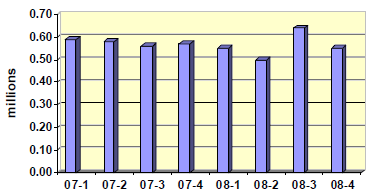
UK Quarterly figs for Commercial Layer
Chick Placings (Average Monthly figures)
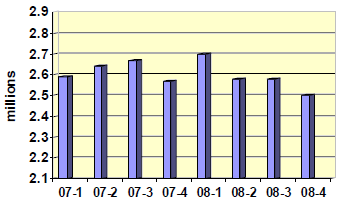
UK Quarterly figs for Commercial Broiler
Chick Placings (Average Monthly figures)
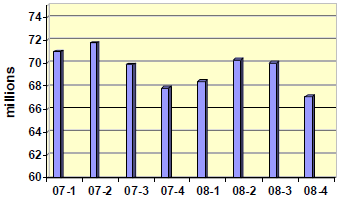
UK Quarterly figs for Turkey Poults
Placings (Average Monthly figures)
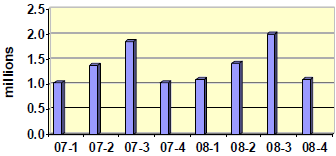
- Slaughterings
Slaughterings (Average monthly figures)

UK Quarterly figs for Broiler
Slaughterings (Average monthly figures)
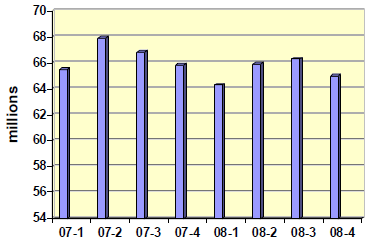
- Meat production
(Average Monthly Figures)

Total Poultry Meat Trade
(Average Monthly figures)
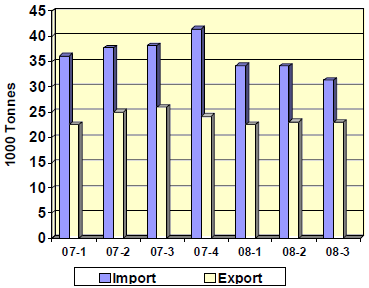
Zoonoses
Salmonella
| In the tables and figures below, an incident is defined as ‘the first isolation and all subsequent isolations of the same serovar or serovar and phage/definitive type combination of a particular Salmonella from an animal, group of animals or their environment on a single premises, within a defined time period (usually 30 days). |
No clinical cases of disease due to S. Enteritidis have been recorded on VIDA in chickens during the quarter, or since 2004 when the last case was recorded.
Sampling of chicken layer flocks according to the requirements of the Salmonella National Control Programme (NCP) for layers is ongoing. More details on the Salmonella NCP in layers can be found on the Defra web site.
The annual number of incidents of S. Enteritidis and S. Typhimurium in turkeys is shown in Table 9 below, and of S. Binza and S. Orion in pheasants in Table 10. In both of these tables the figures for 2008 are provisional.
| Table 9. The annual incidents of S. Enteritidis and S. Typhimurium in turkeys | |||||
| 2004 | 2005 | 2006 | 2007 | 2008 | |
|---|---|---|---|---|---|
| Enteritidis (total) |
0 | 0 | 0 | 0 | 0 |
| Typhimurium (total) |
38 | 23 | 38 | 12 | 1 |
Note: The incidents of S. Enteriditis and S. Typhimurium exclude isolates arising from the 2006/07 EU survey of turkey flocks (see Avian Quarterly Report, 10,(3), July-September 2006, Appendix 1).
| Table 10. The annual incidents of S. Binza and S. Orion in pheasants | |||||
| 2004 | 2005 | 2006 | 2007 | 2008 | |
|---|---|---|---|---|---|
| Binza (total) |
4 | 10 | 21 | 7 | 6 |
| Orion (total) |
1 | 3 | 3 | 2 | 2 |
Endemic Disease Surveillance
Commercial layers and layer breeders
Erysipelas
Two flock episodes of septicaemia due to infection with Erysipelothrix rhusiopathiae, both in free-range organic layers, were diagnosed this quarter. Elevated mortality can persist in affected flocks despite treatment. Ideally, subsequent flocks destined for affected premises would be vaccinated during the rearing period. There is currently no erysipelas vaccine licensed specifically for use in chickens in the UK.
Broilers and broiler breeders
Poor growth and unevenness
A number of birds from broiler flocks were presented for investigation because they were behind target weight and showing variability in size at around 28 to 30 days of age. By the time size differences become noticeable, and birds have fallen a few days behind, the cause (or causes) may be long gone and it can be difficult or, more often, simply not possible to know what caused the problem in the first place. Increased mortality is usually not a feature, and sometimes it can actually be lower than normal. As with the wet litter problems (see Quarterly Report July-September 2008, page 11), in some cases birds showed chronic bursal atrophy raising the possibility of a previous IBD challenge, and a few showed evidence of previous caecal coccidiosis. The exact cause of the poor performance in these cases was not determined.
Spiking mortality
A small number of further cases of Spiking mortality were seen in 24- to 28-day-old flocks. Spiking mortality discussed in detail in the Quarterly Report July-September 2008, page 11.
Riboflavin deficiency
A cluster of cases of riboflavin deficiency in young broilers occurred in one area over a two-week period towards the end of the quarter. Some presented with classical “curled toe paralysis”, with a high percentage of chicks of around 8 to 10 days of age off their legs in some flocks. Response to supplementary multivitamins, including vitamin B2, given in the drinking water was rapid.
Acute rupture of the Achilles tendon complex
Lameness in a small proportion of a flock of breeder pullets in the early part of lay was found to be due in most cases to acute rupture of parts of the Achilles tendon complex (most often the gastrocnemius tendon) of one or both legs. Histological examination confirmed tendon rupture with haemorrhage, in the absence of any evidence of infection in the tendons or tendon sheaths, although sometimes there was evidence of scarring and fibrosis consistent with previous damage adjacent to the site of rupture.
Turkeys
Respiratory disease
Respiratory disease continued to dominate the last quarter of the year. Mycoplasma gallisepticum was detected by DGGE PCR in a case of upper respiratory disease in 8-week-old turkeys being reared for the Christmas market. M. gallisepticum was also isolated from follow-on submissions in a case of acute pneumonia in 8-week-old turkey poults. Mycoplasma meleagridis was detected by DGGE PCR in a group of 10,000 10-week-old turkeys being reared in a polytunnel for the Christmas market. Sinusitis with bilateral swelling of the infraorbital sinuses containing mucopurulent material was seen and mortality of 10 birds-a-day over a seven-day period was described. Turkey rhinotracheitis was suspected in a group of 100 eight-week-old poults with gaping, swollen heads and ocular discharges.
Bacterial pneumonias
Bacterial pneumonias were also seen during the quarter. Ornithobacterium rhinotracheale was isolated from respiratory tract lesions in 15-week-old turkeys. This organism was also identified in conjunction with Mycoplasma synoviae in a septicaemia in 12-week-old turkeys. Wasting and swollen heads were the presenting clinical signs. Deep pectoral myopathy was detected as an incidental finding in the flock. Unilateral pneumonia, infraorbital sinusitis and airsacculitis from which Pasteurella multocida was isolated caused losses in batches of 17-week and 20-week-old turkeys. The infection eventually led to lameness in the same group of birds. Unilateral lung consolidation and necrosis from which P.multocida was isolated also caused losses in 12-week-old poults.
Opisthotonus and mild diarrhoea and 20 per cent mortality in 9- to 12-week-old poults prompted a notification to the DVM of possible involvement of notifiable disease. There was no coughing, sneezing, nasal or ocular discharge but lung consolidation, airsacculitis and fibrinous perihepatitis were seen on post mortem examination. Profuse growths of E. coli were isolated from several sites. Inhalation of faecal-contaminated dust is thought to be the cause of E. coli respiratory infections. A damaged respiratory system allows E. coli to enter the blood circulatory system directly through the air sacs.
Erysipelas
A case of acute erysipelas in six-month-old turkeys presented with congestion of carcasses, petechial haemorrhages in the proventriculus and on the surface of the pancreas and mucoid to haemorrhagic contents in the small intestine, demonstrating the similar, but non-specific, pathological appearance of this disease to avian notifiable diseases such as Newcastle disease and avian influenza. Erysipelas also caused the death of five birds in a flock of 520 turkeys. Pigs had been kept on the premises some years previously and normally the turkeys were vaccinated but the farmer had not done so for the last two years. On a third farm dyspnoea and purple discolouration of the heads was seen in a group of four-month-old turkeys. Mortality was five per cent and Erysipelothrix rhusiopathiae was isolated in septicaemic distribution. Aspergillosis also complicated this case. In another incident, 200 out of 600 turkeys aged five months had died and erysipelas was diagnosed. Feather pecking and cutaneous damage were seen that might have allowed the organism to invade.
Ducks and geese
Pneumonia of unknown aetiology
The pneumonitis due to unidentified organisms reported in the July-September 2008 Quarterly Report (page 13) was seen again this quarter in six-week-old ducklings that were affected by a short fatal illness of two to three hours duration. Lungs were congested grossly and showed diffuse consolidation with obliteration of air capillary spaces associated with numerous basophilic organisms as previously described.
Goose parvovirus
Six cases of suspected goose parvovirus (GPV) were investigated by Avian Virology and VLA Regional Laboratories (RLs), four of which were traced back to a batch of affected goslings imported from Denmark. The investigations resulted in timely communication to the VLA Avian Group, all VLA RLs and Defra and included a GPV veterinary information sheet to be sent to private veterinary surgeons. In addition, a letter summarising the cases was published (Irvine and others, 2008; Veterinary Record, 163: 461). This resulted in heightened awareness and interest from the poultry industry, vets and media, including GPV being in the 'Top 5' of the most popular poultry stories on Farmers Weekly interactive during November, featured in Poultry World and covered on Radio 4’s Farming Today programme in an interview with Jeremy Blackburn (British Poultry Council). These investigations reflected the multiple contributions of all involved across the VLA and RL network, providing further evidence and justification for the value and role of VLA’s scanning surveillance activities.
Backyard Flocks
Listeriosis
Listeriosis is an uncommon diagnosis in poultry but three of a backyard mixed aged flock died after a period of weight loss with no specific clinical signs. Aggregations of serous fluid were present within the peritoneal cavities but the main post mortem finding was enlargement of the spleen, which was indurated with tiny white foci. Listeria monocytogenes was isolated from the spleen. In poultry enteric colonisation with Listeria may occur without birds showing clinical signs and disease is rare although sporadic outbreaks do occur. Clinical signs include sudden death, progressive weight loss or nervous signs. These are associated with either a septicaemic and or an encephalitic infection.
Broiler ascites
Eight backyard broilers died at approximately 12 weeks of age. They had been purchased between four and eight weeks of age and fed ad-lib rearer pellets. One bird examined had a large volume of pale brown fluid with gelatinous clots within the abdomen and an enlarged liver and heart. Broiler ascites was suspected.
This is a recognised condition in rapidly growing broiler birds but not often diagnosed by the VLA in backyard flocks as broiler ascites.
Fungal pneumonia
Aspergillus fumigatus was isolated from lung lesions in a female bantam. This bird as in very poor body condition prior to death and was reported to have shown long term poor weight gain and loose faeces. It was the second of three birds to die. At post-mortem, necrotic plaques were present in both lungs surrounded by an area of dark haemorrhage.
This type of fungal infection usually reflects poor management and poor environmental conditions for the birds. Although it can cause acute respiratory disease and mortality in young birds, survivors can develop slowly progressive respiratory distress and severe loss in condition before death.
Infectious Bronchitis virus (IBV) QX variant
Infectious Bronchitis virus (IBV) QX variant was isolated on two occasions in Great Britain (GB) during 2008 from backyard chickens in Yorkshire and Cornwall. In total, there have been three isolations of IBV QX from backyard chickens since the first reported isolation in August 20071 as a result of VLA scanning surveillance activities for endemic and new and emerging diseases: These episodes clearly highlight the presence of this IBV variant within the poultry population. However, the extent of virus circulation is currently unquantified; hence the potential threat that this novel IBV variant may pose to the commercial poultry sector is unknown. Nephritis appears to be a typical pathological finding in chickens infected with IBV QX, often with elevated mortality. Egg production problems have been reported in layers2,3 and proventriculitis in affected broiler flocks in China4.
- Gough and others, 2008; Veterinary Record, 162: 99-100
- Liu and others, 2006, Archives of Virology, 151: 1133-1148
- Beato and others, 2006, Proceedings of the Fifth International Symposium on Avian Coronaviruses and Pneumoviruses and Complicating Pathogens. Rauischholzhausen, Germany, May 14 to 16, 2006, 167-170
- Yu and others, 2001, Avian Diseases, 45: 416-424
Game birds
Spironucleosis in Game Birds in Great Britain 1996 to 2008
Spironucleosis (at one time referred to hexamitiasis or hexamitosis) is a common cause of weight loss, diarrhoea and death in reared and released pheasants and red-legged partridges. At one time, the prevention and treatment of this condition relied on the use of in-feed and in-water medication containing dimetridazole but in recent years, these products have not been available to the game bird industry. Instead, control is based on good management and hygiene practices, and treatment of affected groups with tetracycline antibiotics in the drinking water appears to be beneficial. Spironucleus meleagridis is a motile protozoan organism found mostly in the small intestine – two other motile protozoa that have been associated with disease in game birds, Trichomonas phasiani and Histomonas meleagridis, are found in the caeca.
A cyclical pattern can be seen between 1996 and 2008, apparently unrelated to the withdrawal of dimetridazole from 2002. However, when the diagnoses are expressed as a percentage of the number of game bird submissions received, it can be seen that the percentage of diagnostic submissions in which spironucleosis was diagnosed has been steadily increasing since 2005.
Disease was especially common in 2007, and a breakdown of the diagnoses by month (Figure 14) shows that this rise was largely the result of increased cases in September 2007. The reason for this is unclear but may be related to the fact that mean temperatures in August 2007 were the coldest in many areas of GB for over ten years, possibly adversely affecting the health of the birds immediately prior to September 2007.
These figures suggest that spironucleosis will continue to be a problem for game birds in the years to come, and that the control of this disease should form a major part of health plans prepared by game bird rearers and their veterinary advisers.
Further Reading
| - | You can view the full report by clicking here. |
May 2009








